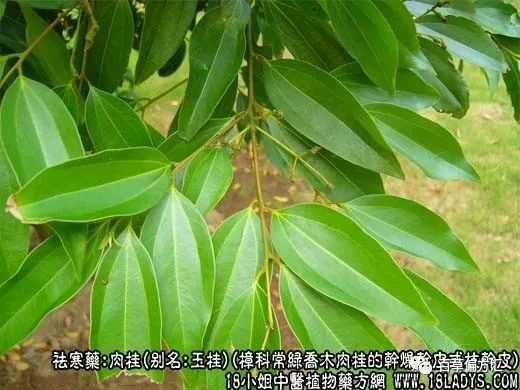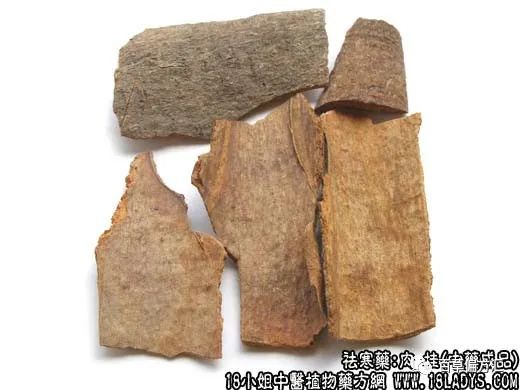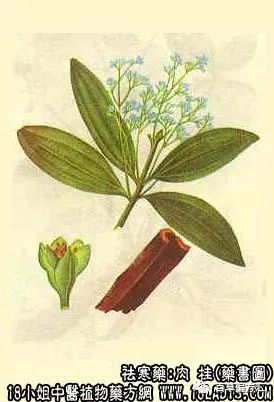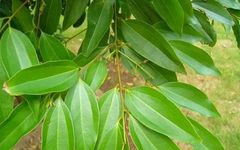


This product is a commonly used traditional Chinese medicine. It is classified as a superior product in the “Shennong Bencao Jing” (Shennong’s Classic of Materia Medica).
Alias: Yu Gui (Jade Cinnamon), You Gui (Oily Cinnamon), Mu Gui (Bark Cinnamon).
Source: This product is the dried bark or branch bark of the evergreen tree Cinnamomum cassia, belonging to the Lauraceae family. It is mostly cultivated, with some wild varieties.
Production Areas: Mainly produced in Pingnan, Guiping, Cenxi, Tengxian, Qinzhou, and Dongxing in Guangxi; and in Gaoyao, Deqing, and Luoding in Guangdong.
Identification: The bark from the Guangxi region is long and grooved, with the edges curling inward, forming a cylindrical or flat cylindrical shape. The center of the groove is slightly raised, appearing slightly sunken from the outer bark. It measures about 30-45 cm in length and 10-13 cm in width (excluding the curled edges of 4.5-6 cm), with a thickness of about 3-5 mm. The outer bark is gray-brown or brown. Each end has a 5 mm section where the cork has been removed, appearing brown. The entire surface has irregular horizontal pores and numerous small protruding tubercles, occasionally with slightly raised horizontal wrinkles and gray-green mottling (marks left by mosses, commonly referred to as colorful skin). The inner surface is yellow-brown or brown and smooth. When scratched with a nail, it shows deep brown oil patterns. It has a strong sweet aroma and a sweet and spicy taste.
The best quality has a fine skin with colorful skin, sufficient oiliness, a sweet and spicy taste, and minimal astringency when chewed. Other specifications can be referenced in the notes.
Main Components: Contains volatile oil, primarily cinnamaldehyde, along with cinnamyl acetate and a small amount of benzaldehyde.
Efficacy and Functions: 1. Warms the middle and disperses cold, mainly by dilating blood vessels to enhance blood circulation and has a certain diaphoretic effect. Due to its ability to promote blood circulation, it helps enhance the efficacy of other medicines. Historical experience states that cinnamon can “unblock the blood vessels” and “guide all medicines,” indicating that “wherever other medicines cannot reach, cinnamon will guide them there.”
2. Strengthens the stomach: Promotes gastric juice secretion.
Preparation: Remove the cork, crush or grind into powder.
Properties: Spicy, sweet, and very warm.
Meridians: Enters the Liver (Gan), Kidney (Shen), and Spleen (Pi) meridians.
Functions: Warms the Spleen and Stomach, warms the lower back and kidneys, unblocks blood vessels, disperses and alleviates pain.
Indications: Spleen and Stomach deficiency cold, abdominal distension and pain, indigestion, Kidney deficiency lower back pain, diarrhea and abdominal pain, blood cold menstrual disorders.
Clinical Applications: 1. Used to treat Yang deficiency with internal cold and weak Kidney Qi. For patients with chronic diseases or weakened constitutions presenting with loose stools, shortness of breath, lower back pain, and weak pulse, it can be combined with Fuzi (Aconite) in tonifying Liver and Kidney formulas, such as the Fuzhu Bawei Wan.
2. Used to treat cold abdominal pain, poor appetite, upper abdominal fullness, or vomiting or diarrhea, taking advantage of its stomach-strengthening properties, as in the Anzhong San.
3. Used in gynecology to treat lower abdominal cold pain, late menstruation (scanty periods), with blood-activating and menstrual-regulating effects. Historical experience states: “Lower abdominal cold pain cannot be alleviated without cinnamon.” If the lower abdominal pain is not closely related to menstruation, it can be combined with Yanhusuo (Corydalis), Danggui (Angelica), and Chuanxiong (Szechuan Lovage); if it is premenstrual pain, it can be combined with Chishaoyao (Red Peony), Taoren (Peach Kernel), and Danggui; if it is post-menstrual pain with lower abdominal cold pain, it can be combined with Ganjiang (Dried Ginger), Qiaocai (Mugwort), and Buzhong Yiqi Wan. Caution is advised for pregnant women when using cinnamon.
4. Used for patients with blood deficiency and weak Qi. In formulas for tonifying blood and Qi, cinnamon is often included to activate blood circulation and improve digestive absorption, allowing tonics to work better, as seen in the Shiquan Dabu Tang (Ten Complete Great Tonifying Decoction) and the Baoyuan Tang (Preserving Original Decoction), both of which include cinnamon.
Additionally, because cinnamon can activate blood circulation, it can enhance diuretic effects in diuretic formulas; in formulas for abscesses, it can enhance the dispersing effect on Yin abscesses (cold-type pus abscesses).
Usage Notes: 1. Both cinnamon and Fuzi can warm the middle and disperse cold, but cinnamon’s heart-strengthening and body-function stimulating effects are not as strong as Fuzi, and it has a certain dispersing (diaphoretic) effect, so Fuzi is used in cases of shock and collapse rather than cinnamon.
2. The effective components of cinnamon are easily volatile, so it is generally not used in decoctions but is better taken as a powder. However, some advocate for its use in improving circulation and in tonics, suggesting it is better taken as a decoction when used for warming the middle and dispersing cold and for stomach-strengthening purposes.
3. Comparison of Guizhi (Cinnamon Twig) and cinnamon: Guizhi is better for warming meridians and unblocking collaterals, while cinnamon is better for warming the kidneys and dispelling cold.
Dosage: Decoction 0.9-3g. Powdered form 0.6-1.5g.
Example Formulas: 1. Anzhong San: Cinnamon 2.4g (decocted), Yanhusuo 9g, Cumin 9g, Galangal 9g, Calcined Oyster Shell 18g (first decocted), Sand Ginger 6g, Poria 15g, Chishaoyao (Red Peony) 15g, Licorice 6g, decocted in water.
2. Shaofu Zhuyu Tang (“Correction of Medical Errors”): Cinnamon 3g (decocted), Cumin (stir-fried) 7 pieces, Dried Ginger 0.6g, Yanhusuo 3g, Myrrh 3g, Danggui 9g, Chuanxiong 3g, Chishaoyao 9g, Puhuang 6g, Wulingzhi 6g, decocted in water.
Note: 1. There are many specifications for cinnamon, both domestic and imported. Some are cultivated while others are wild. A cinnamon tree that has grown for six years to several decades can yield several different products. The main processing depends on the growth limitations of the cinnamon tree, the thickness and fineness of the bark, and the oil content, which determines the type of product. For example, the processed Guangxi cinnamon with a thick bark of 3-5 mm and sufficient oil is classified as Qibian Gui, while those with bark thicker than 5 mm and coarser oil are classified as Yougui, and those with thicker and less oily bark are classified as Bangui. The thicker branch bark with higher oil content is processed into Yougui Tong, while thinner branch bark is processed into Guixin or Guixin.
2. Imported cinnamon was mostly sourced from Vietnam in the past, with many names such as Qinghua Gui, Gaoshan Qibian Gui, and Dingshan Qibian Gui. Due to Vietnam’s subtropical climate, it is suitable for cinnamon growth. Moreover, the Guangxi and Guangdong regions have seen a significant increase in cultivation in recent years, ensuring domestic market needs and exporting abroad, thus reducing the need for imports.
More Exciting Recommendations:
Chinese Herbs: The Efficacy and Functions of Danpi
Chinese Herbs: The Efficacy and Functions of Huashi
【Disclaimer】: Articles reprinted from other platforms or media will be credited, but we do not guarantee the accuracy, reliability, or completeness of the content. For reference only. If there is any infringement, please contact us with relevant proof, and we will correct the source and author or delete the article based on the copyright owner’s opinion, and we do not bear any other responsibility.
The above contentis sourced from the internet,for reference only,infringement will be deleted!
Follow your doctor’s advice! Do not self-medicate! Share with friends,the more people see it, the more health benefits!
Share with friends,the more people see it, the more health benefits!

